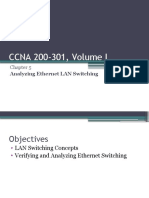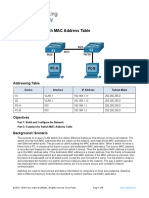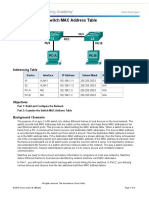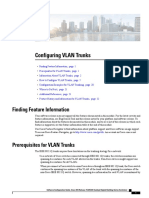Configuring MAC Address Tables: Information About MAC Addresses
Uploaded by
earespConfiguring MAC Address Tables: Information About MAC Addresses
Uploaded by
earespConfiguring MAC Address Tables
• Information About MAC Addresses, on page 1
• Configuring MAC Addresses, on page 1
• Configuring MAC Move Loop Detection, on page 4
• Verifying the MAC Address Configuration, on page 5
Information About MAC Addresses
To switch frames between LAN ports, the switch maintains an address table. When the switch receives a
frame, it associates the media access control (MAC) address of the sending network device with the LAN
port on which it was received.
The switch dynamically builds the address table by using the MAC source address of the frames received.
When the switch receives a frame for a MAC destination address not listed in its address table, it floods the
frame to all LAN ports of the same VLAN except the port that received the frame. When the destination
station replies, the switch adds its relevant MAC source address and port ID to the address table. The switch
then forwards subsequent frames to a single LAN port without flooding all LAN ports.
You can also enter a MAC address, which is termed a static MAC address, into the table. These static MAC
entries are retained across a reboot of the switch.
You cannot enter a multicast address as a statically configured MAC address, both for IP multicast and non-IP
multicast MAC addresses. This is not supported by the N3548 platform.
The address table can store a number of unicast address entries without flooding any frames. The switch uses
an aging mechanism, defined by a configurable aging timer, so if an address remains inactive for a specified
number of seconds, it is removed from the address table.
Configuring MAC Addresses
Configuring Static MAC Addresses
You can configure static MAC addresses for the switch. These addresses can be configured in interface
configuration mode or in VLAN configuration mode.
Configuring MAC Address Tables
1
Configuring MAC Address Tables
Disabling MAC Address Learning on Layer 2 Interfaces
SUMMARY STEPS
1. switch# configure terminal
2. switch(config) # mac address-table static mac_address vlan vlan-id {drop | interface {type slot/port}
| port-channel number}
3. (Optional) switch(config)# no mac address-table static mac_address vlan vlan-id
DETAILED STEPS
Command or Action Purpose
Step 1 switch# configure terminal Enters global configuration mode.
Step 2 switch(config) # mac address-table static mac_address Specifies a static address to add to the MAC address table.
vlan vlan-id {drop | interface {type slot/port} |
port-channel number}
Step 3 (Optional) switch(config)# no mac address-table static Deletes the static entry from the MAC address table.
mac_address vlan vlan-id
Use the mac address-table static command to assign a
static MAC address to a virtual interface.
Example
This example shows how to put a static entry in the MAC address table:
switch# configure terminal
switch(config) # mac address-table static 12ab.47dd.ff89 vlan 3 interface ethernet 1/4
switch(config) #
Disabling MAC Address Learning on Layer 2 Interfaces
You can now disable and re-enable MAC address learning on Layer 2 interfaces.
SUMMARY STEPS
1. switch# configure terminal
2. switch(config)# interface type slot/port
3. switch(config-if)# [no] switchport mac-learn disable
4. switch(config-if)# clear mac address-table dynamic interface type slot/port
DETAILED STEPS
Command or Action Purpose
Step 1 switch# configure terminal Enters global configuration mode.
Step 2 switch(config)# interface type slot/port Enters the interface configuration mode for the specified
interface.
Step 3 switch(config-if)# [no] switchport mac-learn disable Disables MAC address learning on Layer 2 interfaces.
Configuring MAC Address Tables
2
Configuring MAC Address Tables
Configuring the Aging Time for the MAC Table
Command or Action Purpose
The no form of this command re-enables MAC address
learning on Layer 2 interfaces.
Note In Warp mode, the Cisco Nexus 3500 switch
does not flood Layer 3 traffic to the VLAN in
which the port configured using switchport
mac-learn disable is present, and the traffic is
dropped. In Normal mode, the switch should
flood the Layer 3 traffic to this VLAN.
Step 4 switch(config-if)# clear mac address-table dynamic Clears the MAC address table for the specified interface.
interface type slot/port
Important After disabling MAC address learning on an
interface, ensure that you clear the MAC address
table.
Example
This example shows how to disable MAC address learning on Layer 2 interfaces:
switch# configure terminal
switch(config)# interface ethernet 1/4
switch(config-if)# switchport mac-learn disable
switch(config-if)# clear mac address-table dynamic interface ethernet 1/4
This example shows how to re-enable MAC address learning on Layer 2 interfaces:
switch# configure terminal
switch(config)# interface ethernet 1/4
switch(config-if)# no switchport mac-learn disable
Configuring the Aging Time for the MAC Table
You can configure the amount of time that an entry (the packet source MAC address and port that packet
ingresses) remain in the MAC table. MAC aging time can be configured in either interface configuration mode
or in VLAN configuration mode.
Note The Cisco Nexus device does not support per-VLAN CAM aging timers.
SUMMARY STEPS
1. switch# configure terminal
2. switch(config)# mac-address-table aging-time seconds
DETAILED STEPS
Command or Action Purpose
Step 1 switch# configure terminal Enters global configuration mode.
Configuring MAC Address Tables
3
Configuring MAC Address Tables
Clearing Dynamic Addresses from the MAC Table
Command or Action Purpose
Step 2 switch(config)# mac-address-table aging-time seconds Specifies the time before an entry ages out and is discarded
from the MAC address table.
The seconds range is from 0 to 1000000. The default is
1800 seconds. Entering the value 0 disables the MAC aging.
Example
This example shows how to set the aging time for entries in the MAC address table to 1800 seconds
(30 minutes):
switch# configure terminal
switch(config) # mac-address-table aging-time 1800
switch(config) #
Clearing Dynamic Addresses from the MAC Table
You can clear all dynamic entries in the MAC address table.
Command Purpose
switch(config)# clear mac-address-table dynamic {address Clears the dynamic address entries from the
mac-addr} {interface [type slot/port | port-channel number} MAC address table.
{vlan vlan-id}
This example shows how to clear the dynamic entries in the MAC address table:
switch# clear mac-address-table dynamic
Configuring MAC Move Loop Detection
When the number of MAC address moves between two ports exceeds a threshold, it forms a loop. You can
configure the action of bringing down the port with the lower interface index when such a loop is detected
by using the mac address-table loop-detect port-down command. To revert to the default action of disabling
MAC learning, use the no form of this command.
SUMMARY STEPS
1. switch# configure terminal
2. switch(config)# [no] mac address-table loop-detect port-down
3. switch(config)# mac address-table loop-detect port-down edge-port
DETAILED STEPS
Command or Action Purpose
Step 1 switch# configure terminal Enters global configuration mode.
Configuring MAC Address Tables
4
Configuring MAC Address Tables
Verifying the MAC Address Configuration
Command or Action Purpose
Step 2 switch(config)# [no] mac address-table loop-detect Specifies the port-down action for MAC move loop
port-down detection. The no form of this command reverts to the
default action of disabling MAC learning for 180 seconds.
Step 3 switch(config)# mac address-table loop-detect port-down Enables the err-disabled detection for the edge-port on the
edge-port MAC move loop detection.
Example
This example shows how to configure port-down as the action for MAC move loop detection.
switch# configure terminal
switch(config)# mac address-table loop-detect port-down
This example shows how to enable the err-disabled detection for the edge-port on the MAC move
loop detection.
switch# configure terminal
switch(config)# mac address-table loop-detect port-down edge-port
Verifying the MAC Address Configuration
Note On Cisco Nexus 3000 and Cisco Nexus 3548 Series platforms, the self router MAC or HSRP VMAC are
dynamically learned by the switch under the following conditions:
• When there is a transient loop in the network due to which the switch receives its own packets.
• When there are spoofed packets where the source MAC is same as the Router MAC or HSRP MAC.
This behavior is different from other Cisco Nexus platforms. However, there is no operational impact due to
these self MAC entries that are present in the MAC table. Any packet that is destined to the router MAC or
HSRP MAC is routed. There is no Layer 2 lookup on these packets.
Use one of the following commands to verify the configuration:
Table 1: MAC Address Configuration Verification Commands
Command Purpose
show mac address-table aging-time Displays the MAC address aging time for all VLANs defined in the
switch.
show mac address-table Displays the contents of the MAC address table.
Note IGMP snooping learned MAC addresses are not displayed.
show mac address-table loop-detect Displays the currently configured action.
Configuring MAC Address Tables
5
Configuring MAC Address Tables
Verifying the MAC Address Configuration
This example shows how to display the MAC address table:
switch# show mac address-table
VLAN MAC Address Type Age Port
---------+-----------------+-------+---------+------------------------------
1 0018.b967.3cd0 dynamic 10 Eth1/3
1 001c.b05a.5380 dynamic 200 Eth1/3
Total MAC Addresses: 2
This example shows how to display the current aging time:
switch# show mac address-table aging-time
Vlan Aging Time
----- ----------
1 300
13 300
42 300
This example shows how to display the currently configured action:
switch# configure terminal
switch(config)# show mac address-table loop-detect
Port Down Action Mac Loop Detect : enabled
switch# configure terminal
switch(config)# no mac address-table loop-detect port-down
switch(config)# show mac address-table loop-detect
Port Down Action Mac Loop Detect : disabled
Configuring MAC Address Tables
6
You might also like
- HCIE-Routing & Switching V3.0 Training Material PDFNo ratings yetHCIE-Routing & Switching V3.0 Training Material PDF1,133 pages
- 7.3.7 Lab - View The Switch MAC Address TableNo ratings yet7.3.7 Lab - View The Switch MAC Address Table8 pages
- Managing The MAC Address Table: Disabling MAC Address Learning On An Interface or VLANNo ratings yetManaging The MAC Address Table: Disabling MAC Address Learning On An Interface or VLAN4 pages
- 06-MAC Address Table Management CommandsNo ratings yet06-MAC Address Table Management Commands16 pages
- 10-MAC Address Table Attribute ConfigurationNo ratings yet10-MAC Address Table Attribute Configuration5 pages
- Clear - Mac - Address-Table - Dynamic - HTML - CiscoNo ratings yetClear - Mac - Address-Table - Dynamic - HTML - Cisco2 pages
- Avocent Acs 800acs 8000 Advanced Console System Command Reference GuideNo ratings yetAvocent Acs 800acs 8000 Advanced Console System Command Reference Guide49 pages
- MAC Learning Command Reference: This Chapter Describes Commands To Configure MAC Learning.No ratings yetMAC Learning Command Reference: This Chapter Describes Commands To Configure MAC Learning.8 pages
- CCNA 200-301 Chapter 5 - Analyzing Ethernet LAN SwitchingNo ratings yetCCNA 200-301 Chapter 5 - Analyzing Ethernet LAN Switching24 pages
- Using The Command-Line Interface: 2. Analyzing Ethernet LAN SwitchingNo ratings yetUsing The Command-Line Interface: 2. Analyzing Ethernet LAN Switching73 pages
- 01-06 Typical Ethernet Switching ConfigurationNo ratings yet01-06 Typical Ethernet Switching Configuration222 pages
- 7.3.7 Lab - View The Switch Mac Address TableNo ratings yet7.3.7 Lab - View The Switch Mac Address Table5 pages
- 01-05 Typical Ethernet Switching ConfigurationNo ratings yet01-05 Typical Ethernet Switching Configuration103 pages
- 7.3.7 Lab - View The Switch MAC Address TableNo ratings yet7.3.7 Lab - View The Switch MAC Address Table10 pages
- Ethernet Standard: Network Bulls (A Unit of Network Bullstudy Pvt. LTD.) EmailNo ratings yetEthernet Standard: Network Bulls (A Unit of Network Bullstudy Pvt. LTD.) Email9 pages
- 7.3.7 Lab - View The Switch MAC Address TableNo ratings yet7.3.7 Lab - View The Switch MAC Address Table8 pages
- IA1801 - 7.3.7 Lab View The Switch MAC Address TableNo ratings yetIA1801 - 7.3.7 Lab View The Switch MAC Address Table5 pages
- 11-MAC Access Table Configuration CommandsNo ratings yet11-MAC Access Table Configuration Commands7 pages
- 7.3.7 Lab - View The Switch Mac Address Table0% (1)7.3.7 Lab - View The Switch Mac Address Table4 pages
- 7.3.7 Lab - View The Switch Mac Address TableNo ratings yet7.3.7 Lab - View The Switch Mac Address Table4 pages
- 1 - Created by Ahmad Ali E-Mail:, Mobile: 056 430 3717No ratings yet1 - Created by Ahmad Ali E-Mail:, Mobile: 056 430 37172 pages
- 7.3.7 - Lab - View - The - Switch - MAC - Address - Table - STU COMPLETEDNo ratings yet7.3.7 - Lab - View - The - Switch - MAC - Address - Table - STU COMPLETED5 pages
- Sec Data Acl Xe 3s Asr920 Book - Chapter - 0101No ratings yetSec Data Acl Xe 3s Asr920 Book - Chapter - 01018 pages
- 7.3.7 Lab - View The Switch MAC Address TableNo ratings yet7.3.7 Lab - View The Switch MAC Address Table5 pages
- 10-MAC Address Table Configuration CommandsNo ratings yet10-MAC Address Table Configuration Commands6 pages
- 7.3.7-lab-view-the-switch-mac-address-table-1No ratings yet7.3.7-lab-view-the-switch-mac-address-table-15 pages
- Module 14 Layer 2 Security ConsiderationsNo ratings yetModule 14 Layer 2 Security Considerations67 pages
- 7.3.7 Lab - View The Switch MAC Address Table-Đã NénNo ratings yet7.3.7 Lab - View The Switch MAC Address Table-Đã Nén12 pages
- 7.3.7 Lab - View the Switch MAC Address Table(Seng Pisey)No ratings yet7.3.7 Lab - View the Switch MAC Address Table(Seng Pisey)11 pages
- Show Mac Address-Table: Syntax DescriptionNo ratings yetShow Mac Address-Table: Syntax Description3 pages
- Lab - View The Switch MAC Address Table: TopologyNo ratings yetLab - View The Switch MAC Address Table: Topology4 pages
- 7.3.7-Lab - View-The-Switch-Mac-Address-TableNo ratings yet7.3.7-Lab - View-The-Switch-Mac-Address-Table5 pages
- 7.3.7 Lab - View The Switch MAC Address TableNo ratings yet7.3.7 Lab - View The Switch MAC Address Table9 pages
- 5.2.1.7 Lab - Viewing The Switch MAC Address TableNo ratings yet5.2.1.7 Lab - Viewing The Switch MAC Address Table4 pages
- WAN TECHNOLOGY FRAME-RELAY: An Expert's Handbook of Navigating Frame Relay NetworksFrom EverandWAN TECHNOLOGY FRAME-RELAY: An Expert's Handbook of Navigating Frame Relay NetworksNo ratings yet
- Network with Practical Labs Configuration: Step by Step configuration of Router and Switch configurationFrom EverandNetwork with Practical Labs Configuration: Step by Step configuration of Router and Switch configurationNo ratings yet
- Configuring VLAN Trunks: Finding Feature InformationNo ratings yetConfiguring VLAN Trunks: Finding Feature Information22 pages
- 3.2.2.4 Packet Tracer - Configuring TrunksNo ratings yet3.2.2.4 Packet Tracer - Configuring Trunks3 pages
- Chose The Correct Form of The Verb To Be - Am/is/are.: Test Inicial InglesNo ratings yetChose The Correct Form of The Verb To Be - Am/is/are.: Test Inicial Ingles3 pages
- Game Theory Based Bidding Strategy For Prosumers in A Distribution System With A Retail Electricity MarketNo ratings yetGame Theory Based Bidding Strategy For Prosumers in A Distribution System With A Retail Electricity Market5 pages
- Co-Requisite: Prerequisite: Data Book / Codes/Standards Course Category Course Designed by ApprovalNo ratings yetCo-Requisite: Prerequisite: Data Book / Codes/Standards Course Category Course Designed by Approval4 pages
- nbn-Ethernet-Network-Interface-Specification-UNI-DSL-v4-251121No ratings yetnbn-Ethernet-Network-Interface-Specification-UNI-DSL-v4-25112127 pages
- Ethernet Lans: Disney Takes A Ride On Ethernet Disney Rides On Wireless EthernetNo ratings yetEthernet Lans: Disney Takes A Ride On Ethernet Disney Rides On Wireless Ethernet46 pages
- IEEE Standard For Wearable Consumer Electronic Devices - Overview and ArchitectureNo ratings yetIEEE Standard For Wearable Consumer Electronic Devices - Overview and Architecture35 pages
- GGSIPU 8th Sem Syllabus (Credit Karan Uppal)No ratings yetGGSIPU 8th Sem Syllabus (Credit Karan Uppal)7 pages
- 9ARD000015-510 - en AC 800M 5.1 Ethernet IP DeviceNet Installation PDFNo ratings yet9ARD000015-510 - en AC 800M 5.1 Ethernet IP DeviceNet Installation PDF80 pages
- Netmanias.2019.01.22 - 5G Protocol StackNo ratings yetNetmanias.2019.01.22 - 5G Protocol Stack2 pages
- Functional Verification of MAC-PHY Layer of PCI Express Gen5.0 With PIPE Interface Using UVMNo ratings yetFunctional Verification of MAC-PHY Layer of PCI Express Gen5.0 With PIPE Interface Using UVM5 pages
- 5g Lte Narrowband Internet of Things NB Iot 1138317608 9781138317604 CompressNo ratings yet5g Lte Narrowband Internet of Things NB Iot 1138317608 9781138317604 Compress263 pages
- HCIE-Routing & Switching V3.0 Training Material PDFHCIE-Routing & Switching V3.0 Training Material PDF
- Managing The MAC Address Table: Disabling MAC Address Learning On An Interface or VLANManaging The MAC Address Table: Disabling MAC Address Learning On An Interface or VLAN
- Clear - Mac - Address-Table - Dynamic - HTML - CiscoClear - Mac - Address-Table - Dynamic - HTML - Cisco
- Avocent Acs 800acs 8000 Advanced Console System Command Reference GuideAvocent Acs 800acs 8000 Advanced Console System Command Reference Guide
- MAC Learning Command Reference: This Chapter Describes Commands To Configure MAC Learning.MAC Learning Command Reference: This Chapter Describes Commands To Configure MAC Learning.
- CCNA 200-301 Chapter 5 - Analyzing Ethernet LAN SwitchingCCNA 200-301 Chapter 5 - Analyzing Ethernet LAN Switching
- Using The Command-Line Interface: 2. Analyzing Ethernet LAN SwitchingUsing The Command-Line Interface: 2. Analyzing Ethernet LAN Switching
- Ethernet Standard: Network Bulls (A Unit of Network Bullstudy Pvt. LTD.) EmailEthernet Standard: Network Bulls (A Unit of Network Bullstudy Pvt. LTD.) Email
- IA1801 - 7.3.7 Lab View The Switch MAC Address TableIA1801 - 7.3.7 Lab View The Switch MAC Address Table
- 1 - Created by Ahmad Ali E-Mail:, Mobile: 056 430 37171 - Created by Ahmad Ali E-Mail:, Mobile: 056 430 3717
- 7.3.7 - Lab - View - The - Switch - MAC - Address - Table - STU COMPLETED7.3.7 - Lab - View - The - Switch - MAC - Address - Table - STU COMPLETED
- 7.3.7 Lab - View The Switch MAC Address Table-Đã Nén7.3.7 Lab - View The Switch MAC Address Table-Đã Nén
- 7.3.7 Lab - View the Switch MAC Address Table(Seng Pisey)7.3.7 Lab - View the Switch MAC Address Table(Seng Pisey)
- 5.2.1.7 Lab - Viewing The Switch MAC Address Table5.2.1.7 Lab - Viewing The Switch MAC Address Table
- WAN TECHNOLOGY FRAME-RELAY: An Expert's Handbook of Navigating Frame Relay NetworksFrom EverandWAN TECHNOLOGY FRAME-RELAY: An Expert's Handbook of Navigating Frame Relay Networks
- SPANNING TREE PROTOCOL: Most important topic in switchingFrom EverandSPANNING TREE PROTOCOL: Most important topic in switching
- MULTICAST IP ROUTING: MULTICAST IP ROUTING- Part 1From EverandMULTICAST IP ROUTING: MULTICAST IP ROUTING- Part 1
- Network with Practical Labs Configuration: Step by Step configuration of Router and Switch configurationFrom EverandNetwork with Practical Labs Configuration: Step by Step configuration of Router and Switch configuration
- CCNA Exam Excellence: Study Guide & Practice TestsFrom EverandCCNA Exam Excellence: Study Guide & Practice Tests
- Configuring VLAN Trunks: Finding Feature InformationConfiguring VLAN Trunks: Finding Feature Information
- Chose The Correct Form of The Verb To Be - Am/is/are.: Test Inicial InglesChose The Correct Form of The Verb To Be - Am/is/are.: Test Inicial Ingles
- Game Theory Based Bidding Strategy For Prosumers in A Distribution System With A Retail Electricity MarketGame Theory Based Bidding Strategy For Prosumers in A Distribution System With A Retail Electricity Market
- Co-Requisite: Prerequisite: Data Book / Codes/Standards Course Category Course Designed by ApprovalCo-Requisite: Prerequisite: Data Book / Codes/Standards Course Category Course Designed by Approval
- nbn-Ethernet-Network-Interface-Specification-UNI-DSL-v4-251121nbn-Ethernet-Network-Interface-Specification-UNI-DSL-v4-251121
- Ethernet Lans: Disney Takes A Ride On Ethernet Disney Rides On Wireless EthernetEthernet Lans: Disney Takes A Ride On Ethernet Disney Rides On Wireless Ethernet
- IEEE Standard For Wearable Consumer Electronic Devices - Overview and ArchitectureIEEE Standard For Wearable Consumer Electronic Devices - Overview and Architecture
- 9ARD000015-510 - en AC 800M 5.1 Ethernet IP DeviceNet Installation PDF9ARD000015-510 - en AC 800M 5.1 Ethernet IP DeviceNet Installation PDF
- Functional Verification of MAC-PHY Layer of PCI Express Gen5.0 With PIPE Interface Using UVMFunctional Verification of MAC-PHY Layer of PCI Express Gen5.0 With PIPE Interface Using UVM
- 5g Lte Narrowband Internet of Things NB Iot 1138317608 9781138317604 Compress5g Lte Narrowband Internet of Things NB Iot 1138317608 9781138317604 Compress































































































